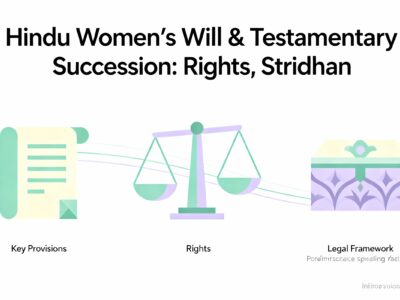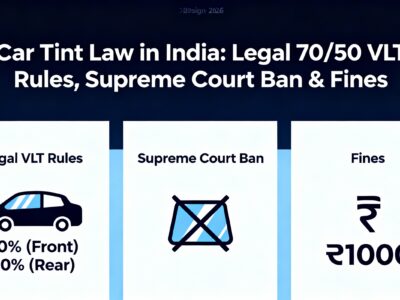The landscape of women’s property rights in India was fundamentally altered by the landmark Supreme Court judgment on Section 15 of the Hindu Succession Act, 1956. For decades, this provision has been at the center of a debate on gender equality, tradition, and constitutional law. This definitive guide breaks down the historical context of the law, analyzes the groundbreaking 2024 verdict in Kamal Anant Khopkar v. Union of India, and explains what the future holds for female inheritance rights in India as of September 2025.
DEEP DIVE: CONSTITUTIONAL LAW
Gender, Tradition, & Equality
A Definitive Guide to the Constitutional Challenge of Section 15 of the Hindu Succession Act, 1956.
Update (September 2025)
The landmark case of *Kamal Anant Khopkar v. Union of India*, which this article analyzes in depth, reached a momentous conclusion in late 2024. In a historic verdict, the Supreme Court **read down Section 15(1)**. It ruled that a Hindu woman's self-acquired property would, in the absence of a husband and children, devolve first upon her own natal heirs (parents) before passing to the heirs of her husband. While the court stopped short of striking down the entire section, it strongly urged Parliament to enact comprehensive legislative reform. This guide explores the legal landscape leading to this judgment and its profound implications for the future of personal law in India.
Key Takeaways of This Guide
- The Core Issue: Section 15 of the Hindu Succession Act, 1956, creates a discriminatory inheritance path for Hindu women who die without a will, prioritizing her husband's family over her own parents.
- Landmark Verdict: The Supreme Court's 2024 judgment in *Kamal Anant Khopkar* partially corrected this, ruling that a woman's self-acquired property will go to her parents before her husband's relatives.
- The Gap Remains: The judgment did not strike down the entire section. Property a woman inherits is still subject to the old 'source of acquisition' rule.
- Constitutional Conflict: The law is challenged under Article 14 (Right to Equality) and Article 15 (Prohibition of Discrimination based on Sex).
- The Final Solution: Complete equality requires Parliament to amend the law, creating a single, gender-neutral succession rule for all Hindus, likely by making Section 8 applicable to everyone.
The constitutional challenge to Section 15 of the Hindu Succession Act, 1956, represented a critical juncture in the long journey of reconciling ancient personal laws with modern constitutional guarantees of equality. The provision, which dictates a discriminatory order of succession for the property of a Hindu female dying without a will, brings into sharp focus the deep-seated patriarchal norms codified into law. This guide dissects the history, the legal battle, and the path forward.
Part I: Foundations of Hindu Succession Law
Section 1: The Arc of Inheritance – A History of Women's Property Rights
The evolution of a Hindu woman's right to property reveals a gradual, often halting, journey. The pre-1956 legal framework was a complex tapestry of Shastric texts and customary laws, which, despite regional variations, shared a common patriarchal thread.
Infographic: Two Types of Property for Women (Pre-1956)
'Stridhan' (Woman's Property)
Property over which a woman had **absolute ownership** and unfettered power of disposal. Sources included gifts from her natal family or husband.
'Woman's Estate' (Limited Estate)
Property she inherited, over which she had only a **life interest**. Upon her death, it reverted to the heirs of the last male owner.
The concept of 'reversion' from the Woman's Estate is the ideological ancestor of the "source rule" in Section 15(2) of the Hindu Succession Act.
1.3 Legislative Precursors: The Hindu Women's Right to Property Act, 1937
This Act was a crucial, albeit flawed, attempt to ameliorate the position of Hindu widows. It interrupted the Mitakshara rule of survivorship, granting a widow the same interest in property as her deceased husband. However, this was a 'Limited Estate', not absolute ownership.
Section 2: The Hindu Succession Act, 1956 – Codification and Reform
The HSA aimed to create a uniform system of inheritance. Its most powerful feature is Section 4, which gives the Act overriding effect over all pre-existing laws and customs. This is critical because it invalidates arguments justifying discrimination based on ancient traditions.
Section 2.1: The Contentious Birth - The Hindu Code Bill Debates
The Hindu Succession Act did not emerge in a vacuum. It was part of the highly contentious Hindu Code Bills, championed by Dr. B.R. Ambedkar in the Constituent Assembly and early Parliament. These bills aimed to codify and reform Hindu personal law, covering marriage, divorce, adoption, and succession, to align them with principles of equality.
The debates were fierce. Orthodox and conservative members vehemently opposed the reforms, arguing they were an attack on Hindu tradition. Dr. Ambedkar's vision was for a radical overhaul granting women equal rights, including an equal share in property. However, to ensure the bills passed, significant compromises were made. Section 15, with its deference to the marital family, can be seen as one such compromise—a partial retention of patriarchal principles to placate traditionalist opposition.
2.2 Section 14: From Limited Rights to Absolute Ownership
A pivotal, and often overlooked, provision of the 1956 Act is Section 14. This revolutionary section converted any property held by a Hindu female as a 'Limited Estate' into her 'Absolute Property' (Stridhan). In one stroke, it abolished the old, restrictive 'Woman's Estate'.
Why Section 14 Matters: By granting women absolute ownership, Section 14 made the question of succession critical. If a woman is the full owner of her property, who has the right to inherit it upon her death? This sets the stage for the controversy surrounding Section 15, which then dictates the line of succession for this newly-granted absolute property.
Context: Mitakshara and Dayabhaga Schools of Law
The HSA codified Hindu law, which historically had two major schools of thought on inheritance:
- Mitakshara School: Prevalent in most of India. Inheritance of joint family property is by survivorship among male coparceners. A son acquires an interest in the family property by birth. The 2005 Amendment made daughters coparceners in this system.
- Dayabhaga School: Prevalent in Bengal and Assam. Inheritance is by succession, not survivorship. No one acquires an interest by birth; rights arise only upon the death of the last owner.
The HSA, especially after the 2005 amendment, largely adopts and modifies the Mitakshara framework, making the concept of coparcenary central to understanding property rights.
The Game-Changer: Hindu Succession (Amendment) Act, 2005
This landmark amendment fundamentally altered the Mitakshara coparcenary by making daughters coparceners by birth, in the same manner as sons. This legislative recognition of a daughter's permanent natal link stands in stark contradiction to the premise of Section 15, which presumes her ties are severed upon marriage.
Part II: The Epicenter of the Controversy
Section 3: A Tale of Two Sections – The Discriminatory Architecture
The Act creates two parallel, yet profoundly unequal, legal universes for inheritance. Section 8 governs for males, and Section 15 for females.
Comparison: Section 8 (Male) vs. Section 15 (Female)
| Parameter | Succession for Male (Sec 8) | Succession for Female (Sec 15) |
|---|---|---|
| Primary Heirs | Mother, Wife, Children (equal footing) | Husband, Children |
| Role of Natal Family | Central. Mother is Class I heir, Father is Class II. | Subordinated. Parents inherit only after husband's entire family. |
| Role of Marital Family | Limited to the wife. Her family has no claim. | Paramount. Husband's family is the entire secondary line of succession. |
| Reciprocity | None. Wife's family cannot inherit. | One-way. Her property flows to husband's family. |
Section 3A: The 'Source of Acquisition' Rule - An Important Caveat (Section 15(2))
While Section 15(1) provides the general rule, Section 15(2) carves out two crucial exceptions. It mandates that if a female dies without children, any property she inherited will revert to the heirs of the person from whom she inherited it.
Infographic: Flowchart of a Hindu Female's Intestate Succession
→ Goes to her Father's Heirs
→ Goes to her Husband's Heirs
→ General Rule of Sec 15(1) Applies
The 2024 SC verdict specifically altered the path for "Self-Acquired" property, prioritizing the woman's parents over the husband's heirs.
Interactive Chart: Who Inherits a Childless Widow's Self-Acquired Property?
Compare the old law (pre-2024 verdict) with other scenarios.
Section 4: The Constitutional Crucible
The challenge to Section 15 was primarily based on two fundamental rights:
- Article 14: Right to Equality. The law fails the test of reasonable classification, as the discrimination lacks a rational nexus to any legitimate object and is manifestly arbitrary.
- Article 15: Prohibition of Discrimination on the Ground of Sex. The law creates a disadvantageous scheme for women based solely on gender, perpetuating patriarchal stereotypes.
Section 4A: The Doctrine of Manifest Arbitrariness
A key weapon in the constitutional challenge was the doctrine of 'manifest arbitrariness'. This test, reinvigorated by the Supreme Court in the landmark case of *Shayara Bano v. Union of India* (the Triple Talaq case), holds that a law can be struck down under Article 14 if it is capricious, irrational, and/or without an adequate determining principle. It goes beyond the traditional "reasonable classification" test.
The petitioners argued that prioritizing distant relatives of a husband over a woman's own aging parents for her self-acquired property is so patently unfair and illogical that it meets this high standard of arbitrariness. There is no sound principle that justifies this scheme, making it a "manifestly arbitrary" provision.
Timeline: Key Judicial Precedents
1983 - Sonubai Yeshwant Jadhav
Bombay HC upholds Section 15, accepting the "family unit" argument. Represents an older, formalistic view of equality.
2009 - Omprakash v. Radhacharan
Supreme Court, though bound by law, calls the outcome "peculiar and absurd," laying the moral groundwork for a future challenge.
2012 - Mamta Dinesh Vakil
Bombay HC reverses its stance, explicitly calling Section 15 discriminatory and paving the way for the current challenge.
2024 - Kamal Anant Khopkar
Supreme Court reads down Section 15(1), a landmark step towards gender justice in property rights for self-acquired property.
Part III: The Contemporary Legal Battle
Section 5: Tradition vs. Constitutional Morality
During the historic hearings, the court debated the role of traditions like 'Kanyadaan' and 'gotra' change. The bench initially expressed hesitation about judicially overturning customs that have "existed for thousands of years."
The core of the legal conflict lies in the doctrine of 'constitutional morality'. This principle posits that the values of the Constitution—such as equality, liberty, and dignity—must override all other considerations, including religious customs, however ancient they may be.
Section 5A: Decoding the Arguments in Court
Arguments of the Petitioners
- Manifest Arbitrariness: Section 15 is irrational and not based on any sound legal principle. It treats women as adjuncts to their husbands.
- Violation of Dignity: The law severs a woman's ties with her natal family, undermining her individual identity and dignity, which is part of Article 21.
- Contradiction with 2005 Amendment: By making daughters coparceners, Parliament has already recognized their enduring link to their birth family. Section 15 is an anachronism.
- No Reciprocity: The law is unfair as it allows the husband's family to inherit from the wife, but not vice-versa.
Arguments of the Union Government
- Preserving the Family Unit: The law aims to prevent property from passing to outsiders and keep it within the marital family unit.
- Legislative Domain: Changing personal laws is a complex matter best left to Parliament, not the judiciary.
- Source of Acquisition (Sec 15(2)): This provision already provides a "balancing act" by ensuring inherited property returns to its source.
- Option of a Will: A woman is free to bequeath her property to anyone she chooses through a will, so the law of succession only applies in its absence.
Section 5B: The Law Commission's Stance - A Consistent Call for Reform
The judiciary's concerns are not new. They echo recommendations made by the Law Commission of India over several decades, which have consistently pointed out the discriminatory nature of Section 15.
-
174th Report (2000): In its report on the "Property Rights of Women," the Commission proposed a complete redrafting of Section 15 to make it more equitable.
-
207th Report (2008): Titled "Proposal to amend the Hindu Succession Act, 1956 as amended by Act 39 of 2005," it explicitly recommended amending Section 15 to give the woman's parents and their heirs precedence over the husband's heirs for her general property.
These reports demonstrate a long-standing consensus in the legal community that the provision is unjust and requires legislative intervention.
Section 5C: The Broader Social & Judicial Context
The Role of Public Interest Litigation (PIL)
It is significant that this challenge reached the Supreme Court as a Public Interest Litigation (PIL). PILs are a powerful tool of judicial activism in India, allowing public-spirited citizens to bring matters of public importance to the court. In the realm of personal law, PILs have been instrumental in pushing for reforms that legislatures have been slow to enact, as seen in the landmark Shah Bano and Shayara Bano cases.
An Intersectional Perspective: Gender, Widowhood, and Age
The discrimination in Section 15 does not operate in isolation. It intersects with other axes of vulnerability. The typical person affected by this law is a widow (a socially disadvantaged status), often elderly, and financially dependent. The law, therefore, compounds her vulnerability by legally severing her from her most likely source of emotional and financial support—her own parents and siblings—in favor of in-laws with whom her connection may have weakened or become strained after her husband's death. This intersectional lens reveals the true, deeply human cost of the discriminatory provision.
Section 6: A Wider Lens – Succession Rights in Other Indian Personal Laws
Comparative Glance: Women's Inheritance Across Faiths
| Personal Law | Key Feature for Women |
|---|---|
| Hindu Law (Post-2024) | For self-acquired property, natal family can inherit before husband's family (if childless). Inherited property still follows source rule. |
| Muslim Law | Receives a fixed, quantifiable share (typically half of a male heir). Natal family remains relevant; no subordination to husband's lineage. |
| Christian Law | Largely gender-neutral and reciprocal. Widow receives a fixed share (1/3 or 1/2), with the rest going to children or blood relatives. |
| Parsi Law | Highly equitable. Widow receives an equal share to that of a son or daughter. No gender discrimination. |
Part IV: The Path Forward and Conclusion
Section 7: Potential Outcomes and Recommendations
While the Supreme Court's 2024 judgment was a monumental victory, it addressed only self-acquired property, leaving the core statutory discrimination intact for inherited property. The ideal and most durable solution lies with the legislature.
The Ultimate Goal: Legislative Reform
Current Law (Partial Fix)
Separate, unequal rules for males & females. SC verdict fixed one part (self-acquired property), but the discriminatory structure remains.
Proposed Solution
Abolish Section 15 entirely. Make the scheme under Section 8 gender-neutral, creating one uniform, fair law for all Hindus.
Section 7A: Socio-Economic Impact and Practical Implications
This legal debate has profound real-world consequences. The old law often left elderly parents of a deceased daughter destitute, while distant, often unknown, relatives of her husband inherited her hard-earned assets. This created immense emotional and financial hardship.
The Ultimate Antidote: The Power of a Will
It is crucial to remember that the laws of intestate succession (dying without a will) are a default mechanism. The most effective way for any individual—male or female—to ensure their property is distributed according to their wishes is by executing a valid will. The 2024 judgment underscores the importance of proactive estate planning to prevent family disputes and ensure one's assets benefit the intended loved ones.
Section 7B: A Global Perspective on Spousal Inheritance
India's previous succession law for Hindu women stood in contrast to inheritance laws in many other parts of the world, which have long moved towards more equitable, spouse-and-bloodline-centric models.
- United Kingdom: Under the Administration of Estates Act 1925, if a person dies intestate without children, the entire estate passes to the surviving spouse. The deceased's parents only inherit if there is no surviving spouse. The spouse is paramount.
- Canada (e.g., Ontario): Provincial laws give a "preferential share" of the estate to the surviving spouse. The amount above this share is then divided between the spouse and other next-of-kin (like parents). The concept of the marital family completely displacing the natal family is absent.
- France: The Napoleonic Code prioritizes descendants. In their absence, the estate is divided between the surviving spouse and the deceased's parents. The spouse does not inherit everything to the exclusion of parents, but they inherit alongside each other, signifying a balanced approach.
This comparison highlights that most modern legal systems prioritize the surviving spouse and the deceased's direct blood relatives (parents, siblings), rather than extending inheritance rights to the spouse's entire lineage while excluding the deceased's own family.
Module: Case Brief of the Landmark Judgment
Kamal Anant Khopkar & Ors. v. Union of India & Anr.
Writ Petition (Civil) No. 136 of 2021 | Supreme Court of India
Multiple writ petitions were filed challenging the constitutionality of Sections 15(1)(b) & 16 of the Hindu Succession Act, 1956. The petitioners were parents of deceased women whose self-acquired properties were set to devolve upon the heirs of their late husbands, to the exclusion of the women's own parents.
1. Whether Section 15(1) violates Articles 14 and 15 of the Constitution by discriminating on the basis of sex.
2. Whether the traditional basis for this law (a woman joining her husband's family) is a valid justification in a modern constitutional democracy.
The Court, exercising judicial restraint, chose not to strike down the provision entirely. Instead, it "read down" Section 15(1). The reasoning was that for a woman's self-acquired property, there is no rational justification to prefer her husband's heirs over her own natal heirs (parents). Such a preference is founded on the outdated notion that a woman loses her identity upon marriage. This is manifestly arbitrary and violates the constitutional guarantee of equality and dignity. The court affirmed that a woman's connection to her birth family is indelible. However, for inherited property, the "source rule" in Section 15(2) was deemed a reasonable principle, and thus the provision was left intact for those cases.
The provision of Section 15(1)(b) is to be read down. In the case of a Hindu female dying intestate and childless, her self-acquired property will first devolve upon her own heirs, starting with her parents, before it can devolve upon the heirs of her husband. The judgment is to apply prospectively.
The Bench made strong observations urging Parliament to consider a comprehensive amendment to the Act to bring about true gender neutrality in all aspects of succession, calling the current state of the law "a relic of the past".
Module: Practical Guidance & Future Outlook
Practical Estate Planning Checklist for Women
Given the complexities of the law, proactive planning is the best way to ensure your assets are distributed as you wish. Here is a practical checklist:
Create a Will (Most Important)
A valid Will overrides intestate succession laws completely. Clearly state who you want to inherit your property. This is the simplest and most powerful tool at your disposal.
Appoint Nominees Carefully
For bank accounts, insurance policies, and investments, appoint a nominee. However, remember that a nominee is often just a trustee; the legal heir under succession law (or your Will) has the ultimate right. Align your nominees with your Will.
Maintain Clear Property Records
Keep clear documentation proving whether a property is self-acquired or inherited. This is crucial as different rules apply to each category, even after the SC judgment.
Review and Update Regularly
Life circumstances change (marriage, divorce, births, deaths). Review your Will and nominations every few years to ensure they still reflect your wishes.
The Politics of Personal Law Reform
Why hasn't Parliament acted, despite decades of recommendations? The answer lies in the complex political landscape of India. Personal laws are deeply intertwined with religious identity. Governments are often hesitant to enact reforms for fear of being perceived as interfering in the religious affairs of a community, which can have significant electoral consequences. This political sensitivity often leads to legislative inertia, placing the burden on the judiciary to push for change through constitutional interpretation.
Module: Glossary of Legal Terms
Coparcener
A person who acquires an interest in the joint family property by birth. Traditionally only males, but the 2005 Amendment made daughters coparceners as well.
Intestate
The legal term for dying without making a valid will.
Reading Down
A judicial tool where a court narrows the interpretation of a law to save it from being unconstitutional, rather than striking it down completely.
Retrospective vs. Prospective
A retrospective law applies to past events. A prospective law applies only to events occurring after it was enacted.
Stridhan
Property over which a woman has absolute ownership. Originally referred to certain gifts, but now includes all her property due to Section 14 of the HSA.
Writ Petition
A formal request filed in a High Court or the Supreme Court to seek a judicial remedy when fundamental rights are violated.
Section 8: Frequently Asked Questions (FAQ)
The 2024 Supreme Court verdict specifically applies to the self-acquired property of a Hindu female. Property inherited from her parents or husband/in-laws is still governed by the 'source rule' under Section 15(2), meaning it reverts to the heirs of the original source. Ancestral property inherited as a coparcener would fall under this inherited category.
The Supreme Court clarified that the ruling will apply prospectively. This means it will not reopen cases of succession that have already been settled and finalized before the date of the judgment. This is done to prevent a flood of litigation and maintain legal certainty for past transactions.
While this judgment moves personal law closer to constitutional principles of equality, it is not a direct step towards a UCC. A UCC would involve creating a single, common set of laws for all citizens regarding marriage, divorce, inheritance, and adoption, replacing the distinct personal laws of different religious communities. This judgment reforms one aspect of Hindu law; a UCC is a much broader legislative project that remains a subject of national debate.
Section 9: Conclusion – An Unfinished Revolution
The constitutional challenge to Section 15 of the Hindu Succession Act, 1956, and the subsequent Supreme Court verdict, represent a profound moment for the rule of law in India. It is a victory for constitutional morality over archaic tradition. The judgment affirmed that the dignity and equality of a woman cannot be subordinated to patriarchal customs that treat her as property being transferred from one family to another. It recognized her as an individual with an unalienable link to her own lineage.
However, the revolution remains unfinished. The judicial intervention, while courageous, is a patch on a fundamentally flawed fabric. The continued existence of separate, gender-based succession schemes is an anomaly in a nation committed to equality. The onus is now squarely on Parliament to finish the task: to heed the decades of recommendations from its own Law Commissions and the strong guidance from the Supreme Court. The final, most enduring step is to enact comprehensive reform, abolish the discriminatory framework of Section 15, and create a truly uniform, equitable, and just law of inheritance for all its citizens.









